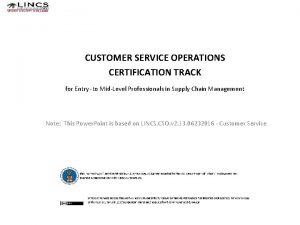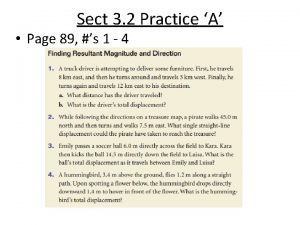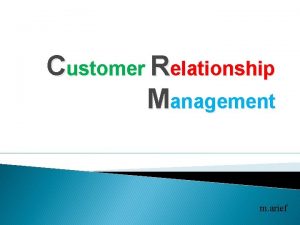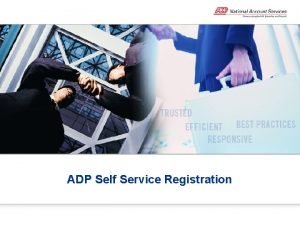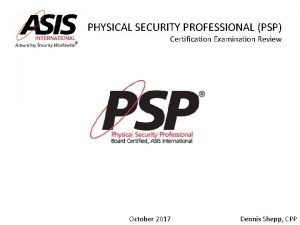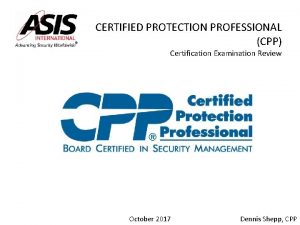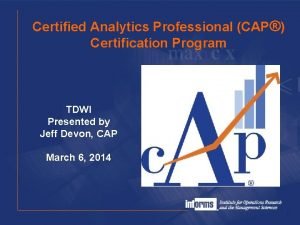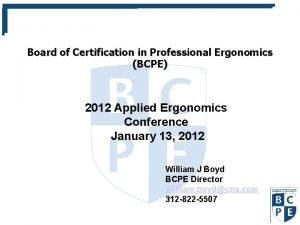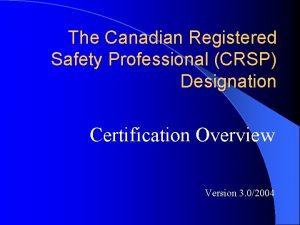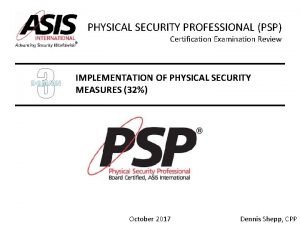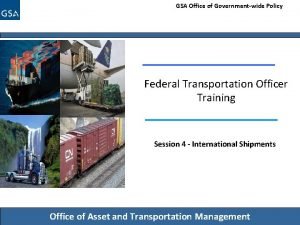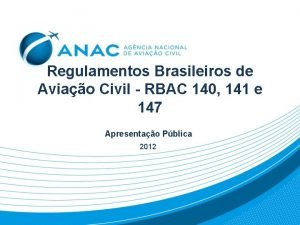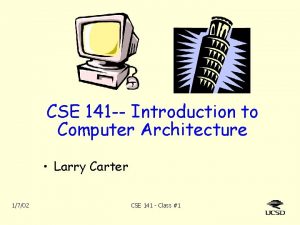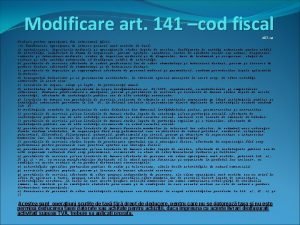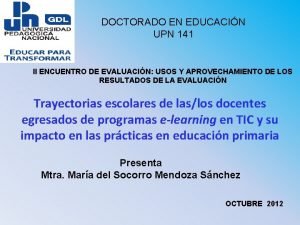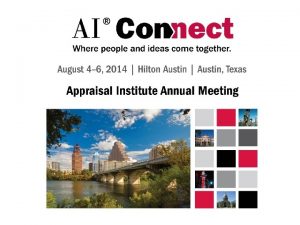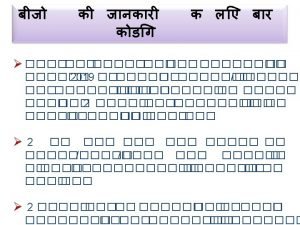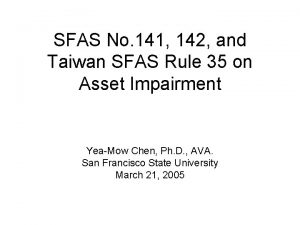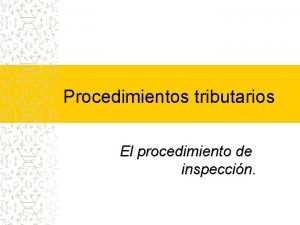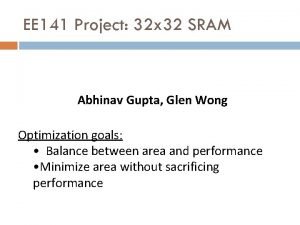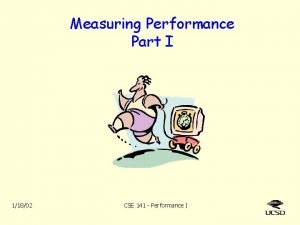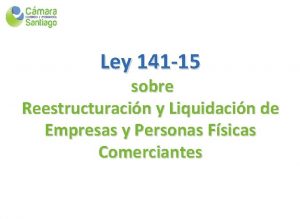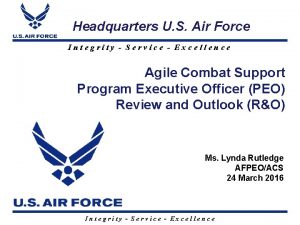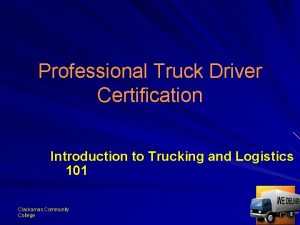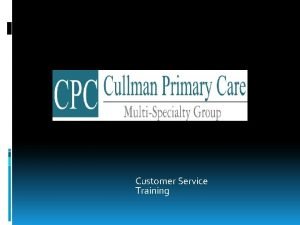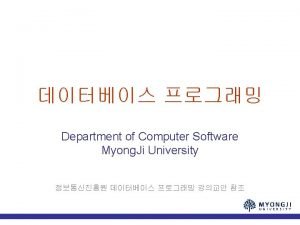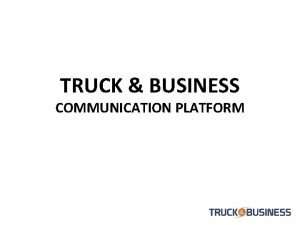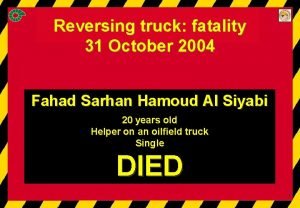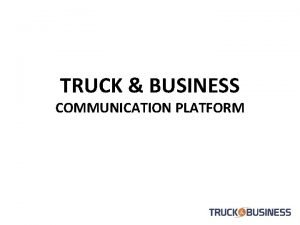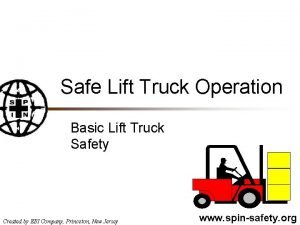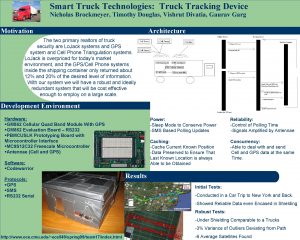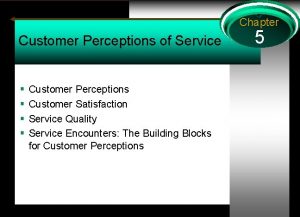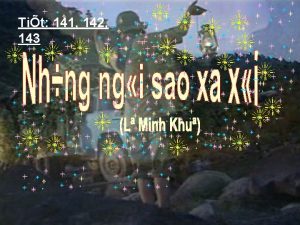Professional Truck Driver Certification Transportation Customer Service 141









































- Slides: 41

Professional Truck Driver Certification Transportation Customer Service 141 Clackamas Community College 1

Grant Funding This product was funded by a grant awarded under the President's High Growth Job Training Initiative, as implemented by the U. S. Department of Labor's Employment & Training Administration. The information contained in this product was created by a grantee organization and does not necessarily reflect the official position of the U. S. Department of Labor. All references to non-governmental companies or organizations, their services, products, or resources are offered for informational purposes and should not be construed as an endorsement by the Department of Labor. This product is copyrighted by the institution that created it and is intended for individual organizational, non-commercial use only. Clackamas Community College 2

Workshop Outcomes 1. Identify the foundation skills for creating loyal customers. 2. Describe behaviors for managing service opportunities. 3. Apply skills, strategies and choices for handling challenging customer situations. 4. Identify and use methods for managing stress to ensure service success. Clackamas Community College 3

Agenda Day One 1. Welcome and Introductions 2. Marketing and Branding 3. Customer Service Basics 4. Listening Skills 5. Day Review and Wrap-up Clackamas Community College 4

Agenda Day Two Welcome Back Verbal and Non-Verbal Communication Devices Difficult and Challenging Customers Day Review and Wrap-up Clackamas Community College 5

Agenda Day Three Welcome Back Difficult and Challenging Customers Negotiation Conflict Resolution Anger Management Day Review and Wrap-up Clackamas Community College 6

Agenda Day Four Welcome Back Stress Management Time Management Road Life Day Review and Wrap-up Clackamas Community College 7

Marketing and Branding Identifies your company Sets an image for others Provides a memory Describes your specialty Clackamas Community College 8

Company Expectations Ensure your clothes are clean and you are personally well groomed Wear company uniforms when required Follow company policy regarding personal hygiene and other dress ornamentals Be positive when you approach the customer Keep a smile on your face Apologize if you are late for any reason (call ahead if possible) Be aware of customer peak hours Gain permission to unload from customer Be polite Say please and thank you to the customer Be professional at all times Clackamas Community College 9

Perspective Quote When we change the way we look at things…the things we look at change. – William Dyer Clackamas Community College 10

Characteristics of Customers Serving them is the reason for which the organization exists The purpose of work, not an interruption from work People who rely on the organization to provide for their wants and needs Know what they want - are not wrong when they tell us what that is Human beings with attitudes and feelings that we cannot ignore Are not concerned with and do not care about the day-to-day dealings inside the business operation Self-centered - only want solutions to their own problems Give loyalty based on a continuously satisfying level of service – loyalty fades as soon as service declines below expectations See the entire cycle of service, not just one element of the organization The source of our paycheck Not all customers are alike, and they do not want to be treated alike Clackamas Community College 11

Facts About Customer Loyalty It costs 5 times more to attract a new customer than to keep an existing one. American businesses will lose 20 percent of their customer base this year. Each unsatisfied customer will tell about 10 other people of their experience; 12 percent tell up to 20 people. Satisfied customers will tell an average of 5 people about their positive experience. 68 percent of customers leave because they feel companies are indifferent or did not like the human side of doing business. 95 percent of customers will give company another chance if their complaints are handled well and quickly. Only 4 percent of customers with complaints, voice them. 15 percent of customers will leave because of quality problems. 15 percent of customers will leave because of price. In many industries quality of service is one of the few variables that can distinguish a business from its competition. Customers are willing to pay more to receive better service. Good service leads to increased sales. The first 30 seconds of a phone call or meeting sets the tone for the remainder of the contact. The last 30 seconds are critical to establishing lasting rapport. Clackamas Community College 12

Assess Yourself Complete the Customer Service Self Assessment Discuss your responses with one other person Identify areas to focus on and develop Clackamas Community College 13

Customer Service Basics Listening Skills Tone of Voice Follow-through Questioning Techniques Non-Verbal Behavior Clackamas Community College Managing Challenging Behaviors Language Positive Attitude Getting Creative 14

3 Levels of Listening Empathic Listening Hearing Words But Not Really Listening in Spurts Clackamas Community College 15

Types of Questions Open Focused Closed Multiple Choice Situational Leading Threatening Clackamas Community College 16

Verbal and Non-Verbal Communication Listening Paraphrasing Asking questions Expressing Empathy Providing Objective Data Clackamas Community College Clarifying Using Silence Building rapport Giving Feedback Receiving Feedback 17

The Power of Words Positive Words I can’t I won’t No way I don’t have time I’m afraid You made me I don’t want to Clackamas Community College Negative Words I can I will I am sure I will make the time Positively I must/shall You bet 18

Communication Devices and Effective Use Be safe when using communication devices Pull off the side of the road if necessary Know how to use them properly Clackamas Community College 19

Managing Challenging Customers Bullies Power Freaks Gripers Seemingly Nice Customers Egotists I Want Your Supervisor The Curser Clackamas Community College 20

7 Steps Respect Empathy Crack the Egg Listen Identify the Problem Avoid Blame Resolve the Problem Clackamas Community College 21

H. E. A. T. Model HEAR them out. Take the time to listen to their concerns. Respond with EMPATHY. Let them know you understand their frustrations. APOLOGIZE. Let them know we are sorry for their inconvenience. TAKE actions. Call or leave a voicemail to a Supervisor, Marketing Associate, Customer Service Representative, etc. , who can solve the problem. Clackamas Community College 22

9 Tips to Keep Your Cool 1. Keep your voice tone and volume low and speak slowly. 2. Ask no threatening questions. 3. Listen to find out what the customer's real reason is for being 4. 5. 6. 7. 8. 9. difficult. Treat the objection as important even if what the person's saying doesn't seem important to you. Acknowledge the problem, then repeat it to the person to make sure you understand the issue. Don't argue. Apologize—even if you think the customer is wrong. Offer to rectify any problem. If you can't, offer an alternative. Act professionally at all times. Afterwards, analyze the behavior that led to the problem so you can avoid repeating it. Clackamas Community College 23

Negotiation Process Separate the people from the problem Focus on interests, not positions Invent options for mutual gains Insist on using objective criteria Clackamas Community College 24

Negotiation Strategies Tell Sell Negotiate Facilitate Inquire Listen Clackamas Community College 25

Conflict Prevention Building relationships and improving communication is a powerful way to prevent conflict from happening in and out of the workplace. Clackamas Community College 26

Conflict Management Clackamas Community College 27

Resolution Process Step One: Own your part of the conflict. If you are in conflict with another individual or group, think about what you could have done to help cause the conflict. Remember, every time the finger points, three fingers are pointing back. Take some time to reflect upon the situation and be honest with yourself. Step Two: Determine the real problem. There may be many symptoms or reactions to the problem but what is the root cause. Think about this individually and then work with the other party to see if there is consensus around the real problem. Step Three: Determine situation improvements. What needs to happen to improve the situation? What do both parties agree and disagree on and what solutions can be put in place to solve the real problem. Step Four: Create an action plan. Define what the mutual goals, steps, responsibilities and completion dates are for the action plan. Step Five: Check progress. Determine time frames for following-up with one another to make sure the real problem has disappeared. Without this step, it is easy to fall back into old patterns and behaviors. Clackamas Community College 28

Anger Management Anger refers to an internal state (feeling) experienced by the person in question. An angry person experiences some physiological changes, some invisible and some visible. There are some important things to note about anger, and angry people. Clackamas Community College 29

Stress Management People today are feeling stress at unprecedented levels The need for realistic education and training about stress is more important than ever before. Today’s global economy calls for each person at every level to be informed, motivated and working for continuous improvement. Clackamas Community College 30

Stress Quote “God grant me the serenity to accept the things I cannot change, the courage to change things I can, and the wisdom to know the difference. ” – The Serenity Prayer of Reinhold Niebuhr Clackamas Community College 31

Signs of Burnout Communicating Less Feeling Less Energy Experiencing Lower Productivity Late More Often for Work or Appointments Sleep Disturbance Appetite Disturbance Preoccupied with Health and Body Decreased Wants Clackamas Community College 32

Methods for Managing Stress On the Job After Hours Throughout the Day Clackamas Community College 33

Time Management Prioritize your daily work. Do it right the first time. Prepare for phone calls prior to making them. Set aside time for creating new ideas. Listen more -- you will not have to do too much re-work if you listen. Allow time for the unexpected -- do not try to cram too much in a short period. Do not tackle too many tasks at one time. Finish what you start. Make sure you get the instructions from someone else right the first time. Clackamas Community College 34

Time Management Continued Prioritize your daily tasks. Be a decision maker instead of procrastinator. Keep a time log. Record all of your activities, notice what activities are time wasters. Deal with the root cause, not the symptom. Give good instructions. Try to manage your workload during your work hours. Only take work home if it is absolutely necessary. Get organized. Clackamas Community College 35

Managing Personal Resources Finance Immediate Relationships (significant other, children, parents, etc. ) Health and Wellness Extended Family Other Clackamas Community College 36

Managing Fatigue In any one year of driving, there is a one in 200 chance of a semi-trailer being involved in a fatal accident. A recent study reported that car or truck driver fatigue was a contributing factor to between 9. 1 % and 19. 9% of fatal accidents involving trucks, with fatigued car drivers being involved at least as much as fatigued truck drivers. Semi-trailer accidents are more likely to be severe and involve fatalities, as compared with car accidents. Fatigue-related accidents are a major occupational hazard for truck drivers, especially long distance drivers. A recent study reported that "articulated trucks have a high involvement fatigue accidents in comparison with their involvement in other accidents". Clackamas Community College 37

Signs of Fatigue Poor concentration Tired or sore eyes Restlessness Drowsiness Slow reactions Boredom Feeling irritable Making fewer and larger steering corrections Missing road signs Having difficulty in staying in the lane Micro sleeps Clackamas Community College 38

Methods for Managing Fatigue Adjust your car's environment Do not use cruise control; keep your body involved with the driving. Watch your posture. Take frequent breaks. Stop for light meals and snacks. Avoid alcohol entirely. Don't allow your eyes to become fatigued or hypnotized. Wear sunglasses to fight glare (but never wear sunglasses at night). Break the monotony. Turn the radio on for a while, then off. Vary speed levels. Chew gum. Stretch your legs, slap your thighs. Talk to yourself. Sing. Keep your eyes moving. Sleep. Clackamas Community College 39

Managing Life on the Road Finance Relationships Eating Habits Physical Fitness Fatigue Time Management Stress Management Prevention Steps for Successful Trip Planning Clackamas Community College 40

Workshop Closure Assessment(s) Feedback Evaluations Clackamas Community College 41
 Customer service operations certification
Customer service operations certification Jnpt truck registration
Jnpt truck registration A truck driver is attempting to deliver some furniture
A truck driver is attempting to deliver some furniture A truck driver is attempting to deliver some furniture
A truck driver is attempting to deliver some furniture Jnpt truck and driver registration
Jnpt truck and driver registration Pengertian customer relationship
Pengertian customer relationship Self service adp
Self service adp Umdf reflector
Umdf reflector Inland marine transportation
Inland marine transportation Indonesian professional certification authority
Indonesian professional certification authority Physical security professional certification
Physical security professional certification Certified protection professional
Certified protection professional Certified analytics professional cap
Certified analytics professional cap Gis professional certification
Gis professional certification Strategic and competitive intelligence professionals scip
Strategic and competitive intelligence professionals scip Board of certification in professional ergonomics
Board of certification in professional ergonomics Crsp designation
Crsp designation Physical security professional (psp)
Physical security professional (psp) Gsa office of governmentwide policy
Gsa office of governmentwide policy Rbac 141
Rbac 141 ١٤١.ir
١٤١.ir Cse 141
Cse 141 Cse 141
Cse 141 Ee 141
Ee 141 Pt-141 comprar
Pt-141 comprar Art 141 cod fiscal
Art 141 cod fiscal Upn 141
Upn 141 Asc 805 business combinations
Asc 805 business combinations How many months is 141 days
How many months is 141 days Ee 141
Ee 141 D-141
D-141 Chemistry 141
Chemistry 141 Sfas 142
Sfas 142 Art 141 lgt
Art 141 lgt Ieee 141
Ieee 141 Ee 141
Ee 141 134/141
134/141 Cse 141
Cse 141 Ley 141 15
Ley 141 15 Integrity service excellence
Integrity service excellence Ap-121
Ap-121 Marketing information and customer insights are
Marketing information and customer insights are
